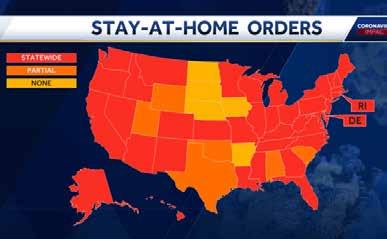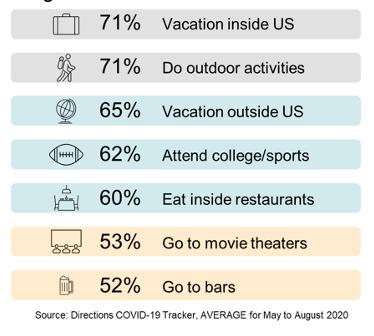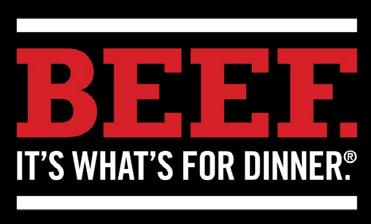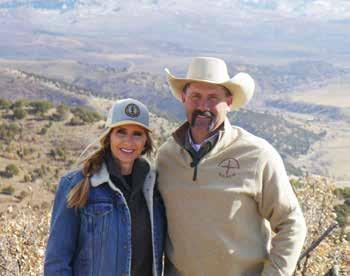
13 minute read
Post pandemic state of the consumer
HINDSIGHT 2020
State of the consumer following months of pandemic
Advertisement
from the Beef Checkoff
THE CONSUMER LANDSCAPE
The year 2020 was transformative and its impact on every corner of our society will be felt for years to come. For many, the year started just like any other, with resolutions for the new year and the hope and promise of a new decade. That quickly changed with the onset of the COVID-19 global pandemic. People experienced disruption in all aspect of their lives and their communities: empty store shelves, fear in the stock market, losing jobs and concern for the economy. This overview provides a snapshot of how domestic consumers have responded to these unprecedented events.
We would be remiss if we did not start with the domestic emergence of COVID-19 and its impact on consumers. As the virus hit, and cities and states went into quarantine, a tremendous impact on job security was noted. According to the U.S Bureau of Labor Statistics, the unemployment rate in April hit nearly 15 percent and stayed above 10 percent for multiple months for the first time since 1982-1983. The good news on the labor front is that August was back in the single digits at about 8.7 percent; however, that is still nearly 5 percent higher than the 2019 average. While we are seeing a downtrend in some areas, 65 percent of consumers still claim to be very concerned6 with COVID-19’s impact. The actual reasons for concern differ for many but regardless, the concern is real and has caused a tremendous emotional toll on consumers. In fact, 30.9 percent of consumers reported depression or anxiety during the pandemic, which is up nearly 4-fold when compared to 2019.
DIGITAL MEDIA HABITS
As quarantine’s and lockdowns continued, consumer’s at-home activities began to shift. Just when you thought consumers could not spend any more time online, online media consumption during the height of the pandemic, continued to grow. According to Nielsen, in Q2 of 2020, 142.5 billion minutes, weekly, were spent streaming video, which is 74 percent higher than


the same quarter in 2019. Outside of streaming, digital website visitation was also up during the pandemic. Total digital website visits increased nearly 50 percent in mid-April and continue to be above 30 percent as of the end of July. All in all, consumers are spending nearly 50 more minutes on app or web-based content through their cell phones or tablets. Regarding beef specifically, searches that ended with consumers landing on Beefitswhatsfordinner.com also saw changes. The most notable were general increases in the top searches for classics like meatloaf, stuffed peppers and preparing London Broil. Additionally, more focus was seen on recipes in general, but specifically oven roasting.
IMPACT ON THE FOOD INDUSTRY
FIGURE 1. UNEMPLOYMENT RATE, AUGUST 2020
FIGURE 2. EAGERNESS TO GET BACK TO ACTIVITIES
FIGURE 3. ONLINE GROCERY AND MEAL ORDERING


The shock that came from the COVID-19 pandemic impacted the food industry immensely and consumer’s food purchasing behavior shifted. Foodservice saw transactions down nearly 80 percent at full-service restaurants and over 40 percent at quick-service restaurants during the peak of the outbreak. This has steadied, and while transactions are not at the level seen last year, some data shows transactions have not gone below a 20 percent decline since August. On the flip side, consumers started stocking up at their local grocery store at an unprecedented national level. As a result of stocking up, retail sales skyrocketed. Looking at meat specifically, sales in July were 36 percent higher than a year ago. For context, 1-2 percent growth in a typical year would be a very positive thing. As a result of this, 91 percent of consumers experienced out of stocks on meat or poultry at some point during the pandemic.
CURRENT SITUATION
Consumer mindset has also been cautious in nature. Since the end of August, only 26 percent of consumers claim to be comfortable with eating inside at a restaurant—when you include comfort of eating outside at a restaurant that number is closer to 40 percent. This is not isolated to food; less than 20 percent of people show comfort in going to the gym, attending indoor or outdoor sporting events, and just over 20 percent are comfortable going to community activities such as church services6. Consumers state that they do want to get back to what they were doing, it is just a matter of when they will be comfortable. Even with a vaccine potentially on the horizon, only 50 percent of people think life will get back to normal when it becomes available. during the pandemic was e-commerce, specifically, online meal and grocery ordering. During the pandemic, 67 percent of consumers claimed they had ordered groceries online at some point and 86 percent claimed to have ordered a meal online. Of those engaged in online ordering for meals/groceries nearly 70 percent mentioned doing it more or just started due to COVID-19. Regarding meat, 73 percent of online baskets contained meat during this time. When asked directly about beef, only 5 percent of consumers indicated they were unsatisfied with their beef experience. All these points together support the accelerated adoption as more people

...CONTINUED FROM PAGE 27
have been ordering through these avenues and are happy with the experience.
As the current environment continues for the near future, it is important to look at some opportunities that may be on the horizon. Consumers are cooking more at home than before. They are looking for meal preparation ideas and recipes to eat some of the food they have on hand or to help change up what they may be looking for. NCBA’s Consumer Beef Tracker, a continuous tracker of consumer perceptions related to the protein landscape, funded by the Beef Checkoff, also shows a shift in what is driving consumption during the pandemic. Yes, taste and the eating experience still dominate the decision process, along with value aspects, but versatility and convenience pop up as a primary driver of consumption during this time. Looking at the retail sales and seeing the versatility mindset of consumers, it makes sense to see ground beef sales made up a large portion of beef’s growth through the pandemic.
OUTLOOK FOR BEEF
Given the lack of comfort and so many questions across the consumer population, it is hard to say when consumers will feel a sense of normalcy. All that said, beef is in a great position. From January to September 2020 the percentage of consumers claiming to eat beef at least weekly has increased from 67 percent to 72 percent compared to 2019. In addition, the number of people with a positive perception of beef has increased, resulting in positive perceptions reaching 70 percent for the first time. NCBA plans to keep this momentum going through the following actions:
Action items delivered by Beef. It’s What for Dinner and other programs, managed by NCBA, a contractor to the Beef Checkoff
• NCBA will continue to complete first-of-its-kind exploratory e-commerce marketing campaigns to help the supply chain accelerate the sales of fresh beef in this rapidly changing environment.
• Consumers are cooking more meals at home now than prior to COVID-19. NCBA will continue to push out cooking information and recipe inspiration through digital, social media and traditional media platforms and leverage impactful, high-profile influencers or thought leaders.
• Consumers are spending more time online and streaming video than prior to COVID-19. NCBA will continue to utilize a variety of marketing platforms (digital/social/traditional) to continuously reach the consumer.
• NCBA will continue to look for opportunities to remind consumers that beef should be the centerpiece of their dinner, especially as we move into the holiday season.
• Beef demand and perceptions have remained strong throughout 2020. Positive consumer perceptions of beef and beef production increased during the pandemic. Consumers increased weekly beef eatings and were willing to pay more for the product. With strong domestic consumer demand-building programs
NCBA is focused on keeping this strong demand going.

In a report released Jan. 20, 2021, researchers from Utah State University Extension and the Utah Department of Agriculture and Food (UDAF) assess the potential for expanding meat processing capabilities in Utah and examine the potential demand for Utah beef.
Researchers conclude that there is growth potential for Utah beef processing and sales, and that Utahns desire local beef products. Small processing plants that position local beef as a premium product are a financially feasible option that could increase the resiliency of the meat supply in Utah and potentially provide ranchers with additional revenue streams.
The report was written by Ruby Ward, professor in the USU Department of Applied Economics. Her co-authors are Karin Allen, USU professor in the Department of Nutrition, Dietetics and Food Sciences; Haden Davis, USU Meat Lab manager; and Anne Whyte, a researcher in the USU Department of Applied Economics.
Contributors to the research from UDAF are Linda Clark Gillmor, director of marketing and economic development; Leann Hunting, director of animal industry; and Noel McSpadden, manager of the state’s Meat and Poultry Inspection Program. The report also recognizes UDAF Commissioner Craig Buttars and former Commissioner Logan Wilde for providing funding support for the research and report.
The research was initiated after the coronavirus pandemic emphasized the need for greater capacity and resiliency in the U.S meat supply chain. Beef production fell 30% within weeks of the declaration of pandemic status, and safety measures implemented shortly thereafter decreased production capacity. Beef producers resorted to other options for processing their animals, and the combination of those factors led to bottlenecks in production and a break in supply.
Prefacing the report with this review of the pandemic’s nationwide impact, researchers examined the state’s current meat processing situation and the potential demand for Utah-produced beef. They assessed the financial feasibility and potential economic contributions of expanded or additional meat processing facilities.
“Utah consumers desire local beef products, and a significant portion are willing to pay a premium for them,” Ward said. “A very small-scale meat processing facility can be feasible but would require that beef is sold and positioned as a premium product.”
Although much of the research referenced in the report focuses on large processing plants, this study focused on a small facility, processing 675 to 750 head annually. Included with the report is a spreadsheet-based tool that allows for modifications to fit the statistics of an existing or theoretical plant. The tool allows meat producers and processors to examine the economic feasibility of an operation at different capacities and pricing.
To access the report and the free Excel-based tool, visit extension.usu.edu/apec/meatprocessing.






Elite Angus genetics!
Building a unique blend of phenotype with outstanding Sired by EPDs, top-tier cow families and raised at high altitude! We focus on building multi-trait bulls that add Featuring the influence of value for you! GAR Ashland! GAR Ashland
Look for us at the Utah Beef Improvement Association March 20 • Salina, UT Offering a powerful set!
Deer Valley Patriot
Plus Enhance, Acclaim, SAV America and more!
VAR Power Play
Private Treaty At the Ranch A select group of bulls and females available. Embryos are available on our best donors!
Offering embryos on donors produced in the Vintage Angus, CA, Wilkes Angus, TX, and Spruce Mountain, CO, programs! Sired by SydGen Enhance, SAV America, and more. Call today!
edr reekc ngusa anchr
2117 W So. Cove Rd • Roosevelt, UT 84066 Bill Muir • 801.694.2041 | Scott Muir • 801.694.4025 bmuir@ubtanet.com
Given in honor of renowned conservationist Aldo Leopold, the prestigious award recognizes farmers, ranchers and foresters who inspire others with their dedication to land, water and wildlife habitat management on private, working land. The Paces were presented with $10,000 and a crystal award at the Utah Farm Bureau Federation’s Annual Meeting in Provo in late 2020.
In Utah the award is presented annually by Sand County Foundation, American Farmland Trust, Utah Farm Bureau Federation, Western AgCredit and Utah Cattlemen’s Association.
The Pace family has installed solar-powered watering systems to improve livestock distribution, forage utilization and water quality at their cattle ranch, Half Circle Cross Ranch. Land is managed to reduce erosion, protect riparian areas and provide habitat for nesting and migrating shore birds. They work with the Nature Conservancy to demonstrate how grazing cattle can help reduce invasive phragmite grasses.
“With all the disruptions that have taken place this year, it’s great to recognize the people that keep raising the food we all need, and at the same time, keep their commitment to doing right on the land as well,” said Ron Gibson, President of the Utah Farm Bureau Federation. “The Pace family are great examples of ranchers that are committed to environmental stewardship, and we congratulate them for this award. While we can only recognize one family with this award, we also want to thank the other finalists and the vast majority of farmers and rancher in our state who feel a sense of responsibility to the land and animals.”
“The Pace family truly demonstrates a commitment to the land in their care. As dedicated conservationists, they understand the importance of preserving and protecting natural resources so they can thrive for generations to come. They are a great example of land owners that have made conservation a way of life, and we appreciate their commitment to bring exemplary stewards of the land and congratulate them on this well-deserved recognition,” said David Brown, Western AgCredit Chief Executive Officer.
“Recipients of this award are real life examples of conservation-minded agriculture,” said Kevin McAleese, Sand County Foundation President and Chief Executive Officer. “These hard-working families are essential to our environment, food system and rural economy.”
“As the national sponsor for Sand County Foundation’s Leopold Conservation Award, American Farmland Trust celebrates the hard work and dedication of the Utah award finalists,” said John Piotti, AFT president and CEO. “At AFT we believe that conservation in agriculture requires a focus on the land, the practices and the people and this award recognizes the integral role of all three.”
Earlier this year, Utah landowners were encouraged to apply (or be nominated) for the award. Applications were reviewed by an independent panel of agricultural and conservation leaders. Among the many outstanding Utah landowners nominated for the award were finalists: Myrin Ranch of Altamont in Duchesne County and Yardley Cattle Company of Beaver in Beaver County.
The first Utah Leopold Conservation Award recipient was Harold Selman Ranches of Tremonton in 2007. The 2019 recipient was JY Ferry & Son, Inc. of Corinne.
The Leopold Conservation Award in Utah is made possible thanks to the generous contributions from American Farmland Trust, Sand County Foundation, Western AgCredit, Utah Farm Bureau Federation, Utah Cattlemen’s Association, Utah Association of Conservation Districts, The Nature Conservancy, Producers Livestock Marketing Association, Utah Department of Agriculture and Food, and Utah Wool Growers Association.
In his influential 1949 book, A Sand County Almanac, Leopold called for an ethical relationship between people and the land they own and manage, which he called “an evolutionary possibility and an ecological necessity.”
Sand County Foundation presents the Leopold Conservation Award to private landowners in 21 states for extraordinary achievement in voluntary conservation. To read the stories of other extraordinary landowners, visit www.leopoldconservationaward.org.










